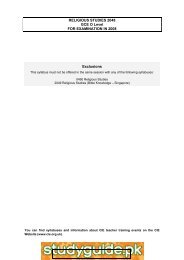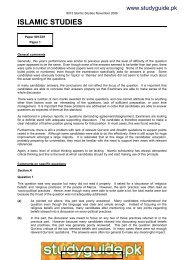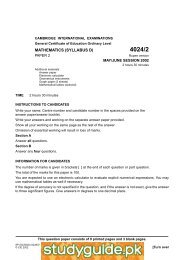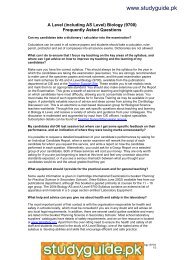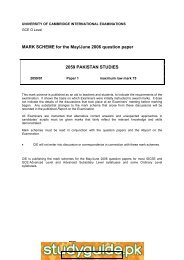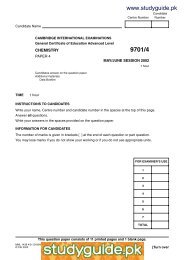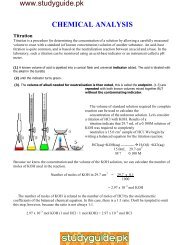1. BASIC ECONOMIC IDEAS..pdf - StudyGuide.PK
1. BASIC ECONOMIC IDEAS..pdf - StudyGuide.PK
1. BASIC ECONOMIC IDEAS..pdf - StudyGuide.PK
Create successful ePaper yourself
Turn your PDF publications into a flip-book with our unique Google optimized e-Paper software.
www.studyguide.pk1SHAPE OF PRODUCTION POSSIBILITY CURVE:Shape 1: ConcaveGood YAPQ0 Good XBThe slope of the production possibility curve is the Marginal Rate of Transformation (MRT)which indicates the rate at which one good is being transformed into another, not physically, but bytransferring resources from one good to another good. As we move along the production possibilitycurve through points P and Q downwards, slope or steepness of each tangent through these pointsincreases. Thus, the production possibility curve takes a concave shape, indicating increasingopportunity cost, that is, the economy is willing to give up more Y for an additional unit of X. There isincreasing opportunity cost because of diminishing returns.Note: slope of PPC = MRT YX = change in Y = opportunity cost of producing an additional unit of X inchange in X terms of Y.Shape 2: ConvexGood YAPQ0 Good XBAs we move downwards from P to Q, the steepness of each gradient falls, i.e, the gradientbecomes flatter. In other words, the slope of the production possibility curve diminishes as we movedownwards. This means that the MRT YX keeps falling, and thus, the opportunity cost is decreasing(increasing returns). The economy is now willing to give up less units of Y for the same additional unitof X.
www.studyguide.pk2Shape 3: LinearGood YAPQ0 B Good XHere the slope of the production possibility curve remains constant. The MRT YX is constant orunchanged as we moved downwards the curve from left to right. Thus, the production possibility curvebecomes linear or straight line. The opportunity cost also remains constant (constant returns). Thismeans that the economy is willing to give up the same amount of Y for the same additional unit of X.SHIFT OF THE PRODUCTION POSSIBILITY CURVE:Good YA 1 Aacb0 Good XB B 1If the economy’s capacity to produce goods is increasing, the production possibility curve will bemoving outwards over time. This indicates that economic growth has taken place. Economic growthshifts the boundary outward and makes it possible to produce more of all goods. Before growth points aand b were on the production possibility curve and point c was unattainable. After growth, point c isattainable.FACTORS RESPONSIBLE FOR THE SHIFT:<strong>1.</strong> Improvement in the state of technology2. Increase in the labour force and labour productivity
www.studyguide.pk33. Increase in capital stock (investment)4. Discovery of new resources.PRODUCTION POSSIBILITY CURVE AND EXCHANGE (through internationaltrade):Good YA20 P (10X, 20Y)16 Q (20X, 16Y)0 Good X10 20 BIn an open economy, suppose a country produces at point P along the production possibilitycurve AB. In other words, with the available amount of resources, it produces 10 units of X and 20 unitsof Y. Combination Q cannot be produced due to scarcity of resources unless there is economic growth.However, even without economic growth, consumption at point Q could be attained only throughexchange, that is, only if the country engages itself in international trade. To attain combination Q, thecountry has to export 4Y and import 10X.<strong>ECONOMIC</strong> SYSTEMS:The central problem of every economic society is to allocate resources in deciding what, how,and for whom to produce. These three questions are dealt with in different ways in each and every
www.studyguide.pk4economy. They are dealt with depending on the economic and political frameworks of that country.Broadly speaking, the economic systems are classified into 3 categories namely:<strong>1.</strong> The market economy or laissez-faire system or capitalist economy.2. The command or planned economy3. The mixed economy.MARKET ECONOMY:In a market economy resource allocation is carried out by private individuals only. All factorsof production are privately owned and managed. There is no government intervention and everyone isfree to operate according to his will and desire. The main characteristics of such a system are:<strong>1.</strong> Price/ market mechanism which manipulates the allocation of resources or tries to resolve thethree fundamental questions of what, how and for whom to produce. In other words, resources areallocated through changes in relative prices. Adam Smith referred to it as the “invisible hands” of themarket.2. Consumer’s sovereignty exists, that is, consumer is a king because it directs the allocation ofresources to a large extent while satisfying its own needs. His basic aim is to maximise satisfaction.The consumer’s decision can dictate economic actions as what and how to produce.3. Producers aim at profit maximisation and rely on higher prices as a “green signal” to higherproduction. The foundation is the profit motive. Evidently, the production of those commodities will bemore profitable which are demanded more by consumers.4. Fierce competition among firms exists and basically it is this competition which encouragestechnological change, innovation and higher investment.5. Easy mobilization of capital due to profit maximisation and regular innovations. Obviously,these do encourage industrialization and economic development.ADVANTAGES OF MARKET ECONOMY:<strong>1.</strong> There is consumer sovereignty. This means that consumers can influence what goods areproduced directly by their purchase. In fact, they are free to buy whatever goods and services from
www.studyguide.pk5which they can derive maximum satisfaction. Similarly, the greater use of price mechanism will providean automatic and quick way to signal to producers what consumers want.2. The market provides a wide variety of goods and services to meet consumer’s wants. Indeed, theconsumers may have a greater choice of a number of private-sector producers. This increasedcompetition may increase the quality of products since rival producers will seek to attract new customersby improving the standard of their goods.3. The market system provides incentives to producers in the form of profits and workers in theform of higher wages. This should encourage entrepreneurs to produce high quality products and toinnovate, and workers to work hard.4. There is greater efficiency. The aim of firms in a market economy is to make maximum profit.Hence, the market system encourages technological change, that is, the use of new and better methodsand machines to produce goods and services at low cost. Those firms, which do not produce whatpeople want at low cost and low prices, may go out of business.MARKET FAILURES / IMPERFECTIONS:In theory the price mechanism can go a long way in efficiently and automatically solving thebasic economic problems. However, in practice it fails in many respects. There are many marketfailures such that the price system cannot ensure the best use of scarce resources:<strong>1.</strong> No provision for public goods or public utilities:Public goods are goods produced on a non-profit maximisation basis because they (streetlighting,defence, roads) aim at maximising socio-economic welfare. Thus, they cannot be producedthrough the market. There is no possibility of fixing a price for the product in question and hence nopossibility of making a profit.2. Divergence between social cost and private cost:Private cost refers to the cost which is incurred in the production of a certain commodity, forexample, labour cost or cost of raw materials. However, when production process takes place, there aresmokes which come from factory chimneys, and garbage or wastes thrown in rivers, thereby, creating
www.studyguide.pk6pollution. Economists evaluate these costs and name them as external costs or negative externalities.These external costs are never considered by a private producer in a market economy. This means thatnothing much is done to reduce pollution and any other destruction caused to nature.3. Harmful products may be produced and consumed:The absence of a government sector implies the absence of taxes and the free operation of themarket mechanism. Left to the price system, there will be overproduction of certain harmful productssuch as drugs, alcoholic drinks and cigarettes. Their high prices initiate higher production and greaterinfiltration of these harmful goods which greatly affect the peaceful life.4. Luxuries in place of necessities:Since allocation of resources depends greatly on those goods whose prices are high or arerising, obviously, the private producers will produce more of these goods and less of other goods maybe essential products. Thus, a rise in the demand of cars may encourage producers to produce more carsand less food which is but an irrational allocation of resources. The system broadly indicates that onlythe rich people have the greater say through their expenditure patterns and the poor, on the hand,remain poor.5. Unequal wealth distribution / inequalities of income:Indeed, the laissez-faire capitalism makes the rich richer and the poor poorer. Systematicexploitation by the capitalists of the poor working class is obvious because they have to maximisereturns and minimise costs, essentially labour costs. The labour cost has to operate at low rates and bevery productive in the production process. In this case, the wealth distribution under this system cannever be reduced.6. Persuasive advertising:Owing to the fierce competition which exists among firms in a pure market system, hugeexpenses are made annually on advertising. The advertising which is adopted is meant for productdifferentiation. Such expenses are usually against customers’ interests because they are not only
www.studyguide.pk7misleading, but also wasteful. Resources used in advertising could have been used somewhere else formore productive purposes.7. Cyclical fluctuations:Cyclical fluctuations are caused by the ever-changing demand and supply conditions.Sometimes, when producers anticipate a rise in demand for certain goods, they raise investment toproduce more. But if demand actually does not rise, a general glut will occur, that is, stockaccumulation. Consequently, the affected producers will have to reduce investment, dismiss workers toreduce costs. Both of these have an adverse effect in the economy as a whole. Less investment meanslower production while lower employment means less consumption, lower prices and profits. Thesecumulative effects lead to a lower national income.It can be deduced that price mechanism determines allocation of resources as per whatconsumers want more which initially sounds right. However, this system cannot be left to itself becauseof its various imperfections which undoubtedly necessitate government intervention.PLANNED ECONOMY:A planned economy is the direct opposite of the market economy. Here all the resources areowned by the government or the public sector which is the central body deciding upon the allocation ofresources. This allocation is however exerted on the following grounds:‣ Maximising socio-economic welfare through creation of public utilities.‣ Non-profit maximising strategy.‣ Parliamentary decisions.However, in real world, command economies seldom exist. Central planners may set the pricesof essential consumer goods, and allow factory managers to set prices of less essential goods. However,such an economic system has got several demerits which can be discussed as follows:<strong>1.</strong> Decisions are based on a parliamentary level:Since decisions are based on parliamentary level, they are not readily implemented and in thisway, several important decisions concerning socio-economic activities may be delayed.2. Inefficiency:
www.studyguide.pk8A common feature against the public sector is inefficiency and lack of competence. The sectoris generally over-staffed and inefficient. The services are of “Red-Tape” type because of high level ofbureaucracy. In addition, the attitude of a secured job in the government sector makes workers idle andcareless about the quality of services to be provided to the members of the public.3. Waste of resources:Very often there is wastage of resources especially when public sector expenditure is analysed.There is a great abuse on the part of the workers concerning the use of public sector resources andmaterials.4. The absence of competition:The absence of competition in this economic system does not ensure innovation and constantimprovements in the quality and quantity of products. Owing to the principle of “No profit- No loss”,huge losses have to be borne at times by the public sector. Therefore, it is difficult to find out additionalresources for innovations.5. Restriction on consumers’ sovereignty:Since there is central allocation of resources, consumers may demand what they wish but to arestricted extent. The production of luxuries is given as the ultimate priority by the government becauseof the concept of the welfare state. Priority must be given only to the production of the most essentialproducts in the society.MIXED ECONOMY:In a mixed economic system, resource allocation is influenced both by the private and publicsectors. In other words, in such an economic system, some economic decisions are taken by the marketmechanism and some by the government planning. It has been found that all modern economies arenow, to varying extent, mixed in nature. Many nations have fluttered from socialism in the course oftime so much so that they have embraced the term mixed economy. Recent developments have
www.studyguide.pk9suggested the superiority of market over planned economies. For instance, the collapse of communismin Russia and Eastern Europe in late 1980s had proved the demise of planning due to ineffectiveresources allocation. On the other hand, predominantly capitalist nations such as USA allowedgovernment to take some economic decisions. Thus, in a mixed economy the price system allocatesresources, but on account of market failures, there is the need for government intervention. In fact, thegovernment has to intervene in order to attain some important micro and macro economic objectives.Role of government planning in a mixed economy:<strong>1.</strong> In a modern mixed economy, the government has to intervene to change the wrong combinationof goods. If left to the price system, there will be over-production and over-consumption of demeritgoods like drugs, cigarettes and alcohol. Hence, the government has to discourage consumption ofthese demerit goods through taxation.2. The government has to provide public goods in a modern mixed economy since provisions ofthese goods are difficult and unsuitable in the hands of private sectors. Defence, roads, street-lightningare provided by the state in every modern mixed economy. Market system cannot compel payment forpublic goods since there is no way to prevent a person who refuses to pay for the good from receivingits services. Thus, the private firms will fail to produce these goods. The government, by virtue of theirpower to tax, can provide the services and collect from everyone.3. In a view to maximising profits, private firms consider only their private costs and privatebenefits. They ignore any external costs and benefits incurred in the production process. Thus, firmstend to produce more of those goods which cause external costs (pollution), but less of those goodswhich cause external benefits. As a result, the government intervention is deemed necessary to correctthe externality by making rules and regulations. The government should subsidise activities whichcause external benefits, while impose taxation to reduce external costs.4. Most government in modern mixed economy have policies designed to discourage firms to actas monopoly. In many countries, important legislations are passed to regulate existing monopolies andprevent informal agreements with the main aim of making profits by exploiting consumers.5. Government may aim to promote the general economic welfare of the population by creating amore equitable distribution of income and wealth. They may aim to achieve this by a system ofprogressive taxation, subsidies and transfer payments.
www.studyguide.pk106. Governments have a large number of macro-economic policy instruments which they use toinfluence, for example, the level of spending, the amount of investment, level of employment, rate ofinflation and international trade position. Their aim is to ensure a steady rise in output andimprovements in living standards.ROLE OF PRIVATE SECTOR IN A MIXED ECONOMY:<strong>1.</strong> Greater competition in the private sector motivates innovations and improvements in the qualityof goods and services provided by the public sector.2. Profits may be used as a guide to efficient allocation and this tends to raise competition andencourage industrialisation.POSITIVE AND NORMATIVE STATEMENTS:It is important to distinguish in the study of economics two types of statements representing themethodology or approach in the scheme of analysis. These statements are positive and normative.Positive statements deal with facts which had already been experienced. In addition, they areconcerned about what is, was or will be. The evolution of life and the society is dynamic and severalexperiences are encountered and it is “positive statements” which would analyse these experiences.
www.studyguide.pk11On the other hand, normative statements depend on our value judgements, i.e, what is good orbad and how things should be. What we want to happen and what really happens are two differentissues. What we want to happen is normative and what really happens is positive.For example, “what policies will reduce unemployment?” and “what policies will preventinflation?” are positive ones, while the question “Ought we to be more concerned about unemploymentthan about inflation?” is a normative one.The statement “A more equal distribution of income would increase national welfare” is a normativestatement, while “An increase in government spending will reduce unemployment and increaseinflation” is a positive one.************************************************************FUNCTIONS OF MONEY:Money must perform the following functions to overcome the problems with barter.<strong>1.</strong> Money must act as a medium of exchange. This means that money allows buying and sellingto run efficiently. An individual can sell his labour service and uses the money to buy other wants.2. Money acts as a measure of value. This means that the value of all goods and services areexpressed in terms of money. Consumers are able to compare the value of different goods. Similarly,businessmen keep record of their transactions in forms of money.3. Money must act as a store of value. This means that members of the public can hold theirwealth in terms of money. An individual can save his money in the bank and use it in the future to buygoods and services.4. Money must act as a standard of deferred payment. This means that credit transactions and hirepurchase can take place. People can acquire goods and services now and payment can be made later.*************************************************************SPECIALIZATION / DIVISION OF LABOUR:Specialization means concentration of factors of production in one particular task in which theyare best suited. A community which practise specialization is able to produce more than enough goodsthan they need. The increased production achieved by specialization is the result of the division oflabour. Division of labour means that each worker concentrates on one job he is best able to do andrelies on the work of others to supply most of his needs. In other words, with division of labour peopleneed to exchange or trade in order to obtain a variety of goods and services to satisfy their wants.
www.studyguide.pk12Division of labour also means the splitting or the breaking up of the whole production process intoseveral processes where each process is performed by one worker or a group of workers who becomespecialist. Division of labour can also be among nations which means that countries, or areas withincountries, specialize in certain kinds of products (comparative advantage).ADVANTAGES OF DIVISION OF LABOUR:<strong>1.</strong> More goods and services can be produced:When workers become specialists in the job they do, repetition of the same operation increasesthe skill and speed of the worker. As a result, more is produced. Division of labour enables massproduction to take place.2. Maximum use of the worker’s ability:With the division of labour there is greater chance that people will be able to do those things atwhich they are best and which interest them the most. Hence, there is improvement in skills.3. Time is saved:Time is saved because workers do not have to move from one operation to another. Time is alsosaved when training people. A worker can be trained very quickly for the performance of a singleoperation.4. It allows the use of machinery:As labour is divided up into specialist tasks, it becomes worthwhile to use machinery whichallows a further saving in time and effort. In fact, division of labour enables the use of more simplemachines.DISADVANTAGES OF DIVISION OF LABOUR:<strong>1.</strong> Work may become boring:A worker who performs the same operation each and every day is likely to become very boredand dissatisfied. This may lead to increased absenteeism and reduced productivity.2. Lost of craftsmanship: When industry applies division of labour, there is a loss in craftsmanship.Division of labour has led to an increase use of machinery. Thus, the basic skills have now beentransferred from the hands of the workers to machines. It is the machines which now control the designand quality of the goods.
www.studyguide.pk133. Workers become too dependent upon each other:Specialization and division of labour means that people come to rely on others for the provisionof goods and services. This illustrates that in many industries, workers have become dependent on theactions of other workers. For instance, if there are several processes in the production of an article, astrike among one group of workers can quickly affect those engaged in other processes.4. Limited knowledge:Division of labour has caused workers to have limited knowledge. The workers only get to knowone job. They do not have the wide training which would make them adaptable to changes in thetechniques of production. Thus, should there be a decline in the demand for their particular skills, theworkers find it difficult to transfer to other occupations. These workers will, therefore, be unemployed.5. Products are all the same:The goods produced under a system of specialization are usually turned out in vast numbers andshare the same design. In other words, they are standardized. It is not possible to please everyonebecause it would be difficult and expensive to change the production process to suit one person’swishes.
www.studyguide.pk14



